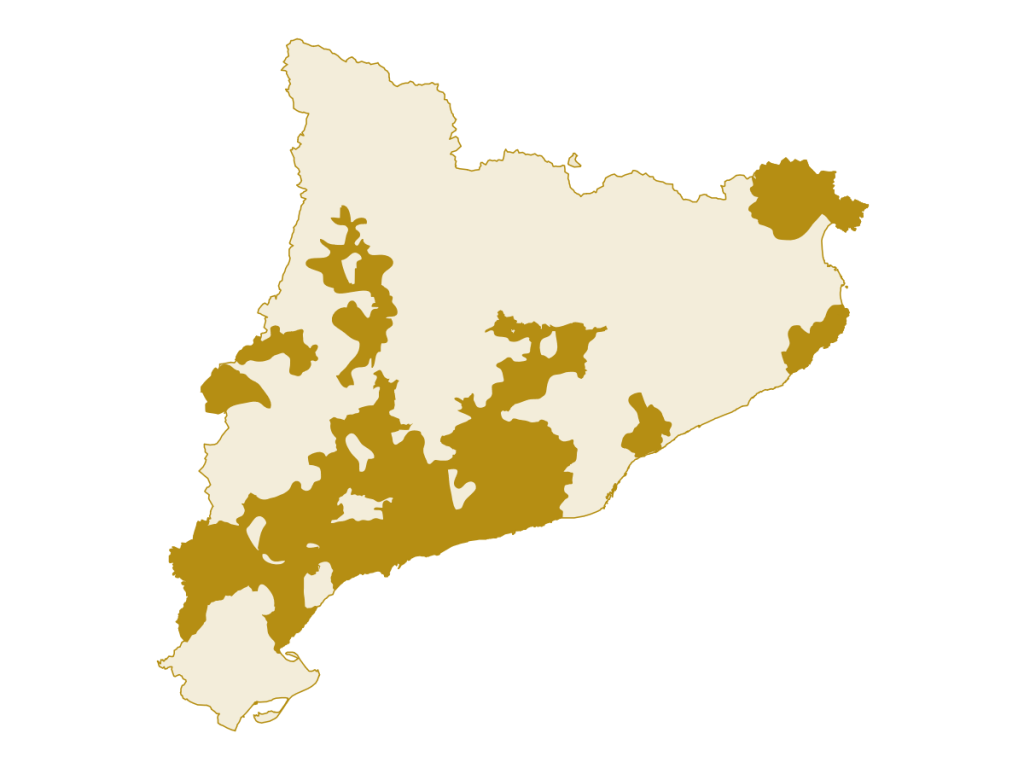The territory of DO Catalunya
The Denomination of Origin Catalunya spreads across the north east of the Iberian Peninsula, between the Mediterranean Sea and the Pyrenees. It is found between 40.3° and 42.5° latitude north, and between 1° and 3.2° longitude east of Greenwich Meridian.
It spans 36.982 hectares of vineyards, distributed between 426 municipalities in Catalonia, in which vineyards have traditionally been cultivated, making it a characteristic, even fundamental element of the landscape and culture.

Our history
Winegrowing tradition in the region is older than the history of Catalonia itself, and wine is an essential element of Catalan and Mediterranean culture. The Phoenicians and the Romans introduced vine cultivation and, since then, wine has formed part of our daily lives, our diet, our culture and our moments of celebration.
Catalonia has exceptional natural conditions: a great diversity of soils, microclimates and orographic conditions, and a geographical location that has allowed variety, quality and continuining enological potential to be achieved.
DO Catalunya, created in 1999, is the heir of this long tradition
A journey through catalan viticulture
4TH CENTURY B.C
Thanks to the Phoenicians and the Greeks, vines are introduced to Catalonia around the Greek metropolis of Emporiom.
2ND CENTURY B.C. AND 5TH CENTURY A.D.
Vine cultivation is strengthened in Catalonia, being cultivated by the Romans themselves.

6TH, 7TH AND 8TH CENTURIES A.D.
Cultivation is halted due to the fall of the Roman Empire, and invasions by the Barbarians and the Moors.
10TH AND 11TH CENTURIES
Catalonia wins independence from the Frankish Kingdom. The city of Barcelona begins to expand, important monasteries are constructed, and vineyards are once again cultivated in the surrounding areas.

1758
Vineyards spread out across the whole of southern Catalonia, becoming the main economic motor, and wine, mistelle and brandy become the principal Catalan exports.
19TH CENTURY (MODERNISM)
The first bodegas arrive, thanks to architects such as Gaudí, Cèsar Martinell and Domènech i Montaner. They are known as “Wine Cathedrals”, for example the cooperative wineries of Pinell del Brai, Falset, Gandesa, Nulles and La Espluga de Francolí.

TRADITION AND MODERNITY
Viticulture in Catalonia continues advancing to keep creating wines of unbeatable quality, which are enjoyed all over the world.
21ST CENTURY
Today, Catalan viticulture has a series of deeply rooted traditions that are expressed through a multitude of activities. Some that particularly stand out are the Harvest Festival, Casteller competitions and countless wine fairs in different winegrowing towns in the Catalan region.
“Strengthen, create and innovate”: the basic guidelines behind DO Catalunya
 
Currently, DO Catalunya includes the vast majority of Catalan municipalities and wine producers. The objective is to progressively improve the quality of wines and vineyards, supporting research and the application of the latest technology as a necessary mechanism for responding to current market demands.
 
“Strengthen, create and innovate” are the basic guidelines behind Denomination of Origin Catalunya. For this reason, it has a wide range of authorized varieties of grape, so that winegrowers and bodegas can produce their wines with flexibility, creativity and freedom.
 
Thanks to DO Catalunya, more wine-producing municipalities that could not be assigned to any other denomination of origin, and which produce great wines, such as a significant part of the region of Anoia or Baix Llobregat, can now be protected by the seal of quality and trust that DO Catalunya certification means for consumers
 
22 million bottles with the DO Catalunya seal were sold in 2003. Now, figures have reached 60.3 million bottles.






